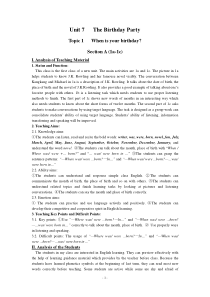 DOC
DOC
【文档说明】《Unit 7 Topic 1 When is your birthday》教案1-七年级下册英语仁爱(科普版).doc,共(4)页,55.000 KB,由小喜鸽上传
转载请保留链接:https://www.ichengzhen.cn/view-104847.html
以下为本文档部分文字说明:
-1-Unit7TheBirthdayPartyTopic1Whenisyourbirthday?SectionA(1a-1c)I.AnalysisofTeachingMaterial1.StatusandFu
nction:Thisclassisthefirstclassofanewunit.Themainactivitiesare1aand1c.Thepicturein1ahelpsstudentstokno
wJ.K.Rowlingandherfamousenovelvisibly.TheconversationbetweenKangkangandMichaelin1aisadescriptionofJ.K.Rowling.Ittalksaboutthedat
eofbirth,theplaceofbirthandthenovelofJ.K.Rowling.Italsoprovidesagoodexampleoftalkingaboutone’sfavoritepeoplewithothers.1bisalisteningtaskwhichne
edsstudentstouseproperlisteningmethodstofinish.Thefirstpartof1cshowsnewwordsofmonthsinaninterestingwaywhichalsoneedsstudentstoknowabout
theshortformsoftwelvemonths.Thesecondpartof1casksstudentstomakeconversationsbyusingtargetlanguage.Thetaskisdesignedasagroup-workcanconsoli
datestudents’abilityofusingtargetlanguage.Students’abilityoflistening,informationtransferringandspeakingwillbeimproved.2.TeachingAims:2.1.Knowle
dgeaims:①Thestudentscanlisten,readandrecitetheboldwords:writer,was,were,born,novel,fan,July,March,April,May,June,August,September,October,N
ovember,December,January;andunderstandthewordnovel.②Thestudentscantalkaboutthemonth,placeofbirthwith“When/Wherewas/were+…
born?”and“…was/werebornin…”③Thestudentscangraspthesentencepatterns:“—Wherewas/were...born?—In…”and“—Whenwas/were...bor
n?—…was/werebornin…”2.2.Abilityaims:①ThestudentscanunderstandandresponsesimpleclassEnglish.②Thestudentscancommunicatethemo
nthofbirth,theplaceofbirthandsoonwithothers.③Thestudentscanunderstandrelatedtopicsandfinishlearningtasksbylookingatpict
uresandlisteningconversations.④Thestudentscansaythemonthandplaceofbirthcorrectly.2.3.Emotionaims:①Thestudentscanpracticeanduselanguage
activelyandpositively.②ThestudentscandeveloptheircompetitiveandcooperativespiritinEnglishlearning.3.TeachingKeyPointsandDifficultPoints:3.
1.Keypoints:①Use“—Wherewas/were...born?—In…”and“—Whenwas/were...born?—…was/werebornin…”correctlytotal
kaboutthemonth,placeofbirth.②Useproperlywaysinlisteningandspeaking.3.2.Difficultpoints:Theusageof“—Wherewas/were...born?—In…”and“—Whenwas/
were...born?—…was/werebornin…”II.AnalysisoftheStudentsThestudentsinmyclassareinterestedinEnglishlearning.Theycanprevieweffectivelywiththehel
poflearningguidancematerialwhichprovidesbytheteacherbeforeclass.Becausethestudentshavelearnedphoneticssymbolsatthebeginningoflastterm,they
canreadmostnewwordscorrectlybeforeteaching.Somestudentsareactivewhilesomeareshyandafraidof-2-makingmist
akes.ThedifferentEnglishlevelsofstudents’maketeamworknecessary.III.AnalysisofTeachingMethodsandAids1.TeachingMethods:TheTask-basedteachingmethod,Com
municativeapproachteachingmethod,SituationalapproachteachingmethodandCompetitionteachingmethodcanarousestudents’learninginterest,makestuden
tslearnaboutteamworkandincreasetheclassefficiency.2.TeachingAids:Blackboard,chalks,themultimediateachingsystem,PPT,learni
ngguidancematerial.IV.AnalysisofLearningStrategiesEnglishsongslearningstrategycanintereststudentstopredictlanguagepoints.In
dependentandcompetitivelearningstrategycanarousestudentstodiscoverandsolveproblemsbythemselves.Cooperativelearningstrategyanddiscussioncandevelopd
ifferentstudents’level.Pictures,keywordsandphrasescanhelpstudentstofinishlisteningtasksmoreeasilyandcorrectly.Previewingandreviewingaregoodhabi
tsinlearning.V.TeachingProcedures1.OverallPlan:Warm-up(3minutes)----Pre-listening(12minutes)----While-listening(10minutes)----Post-listening(10
minutes)----Summary(4minutes)----Homework(1minute).2.DetailsTeachingProceduresandPurpose:2.1.Preparingbefor
eclass:ReadthephoneticsintheWordsandExpressionsinEachUnitofP55ofthestudents’textbook.Thenwritethemdown.Re
adaloudandtrytoreciteallofthem.1.['raɪtə]__________2.['nɒvl]___________3.[wɒz]___________4.[bɔːn]___________5.[dʒu'laɪ]_
_________6.[fæn]___________7.[mɑ:tʃ]__________8.['eɪprəl]__________9.[meɪ]__________10.[dʒu:n]___________10.['ɔ:gəst]__________11.[wə(r)]_______
_12.[sep'tembə(r)]_______________13.[ɒk'təʊbə(r)]________________14.[nəʊ'vembə(r)]_______________14.[dɪ'sembə(r)]____________
____16.['dʒænjuəri]_______________Ican’treadandrecitethewords:_____________________________________________Afterprevie
wing,Idon’tknow:______________________________________________Purpose:Studentscanprevieweffectivelybyreadingthephoneticsandrec
itethewords.Inclass,theycanpaymoreattentiontothewordstheydon’tknow.Itmakeslearninginclassmorepurposeful
ly.2.2.LearningprocedureinClass:Step1Warm-up:1)Greeting.2)Lead-in:Letstudentswatchtheflash“HappyBirthday”andtalkaboutit.Thenleadtothenewclass.A
ndlearnnewsentencepatterns“---Whenwereyouborn?---Iwasbornin…”.Purpose:Studentscanreviewexpressionsthattheyh
avelearntbeforeandit’seasytoleadinthenewlesson.Itarousesstudentsinterestinlearning.Step2Pre-listening:1)Learnnewwordsoftwelvemonths:Letastudentlead
toreadtwelvemonths.Purpose:Somestudentshavelearnedthetwelvemonthsintheirprimaryschoolwhilemostofthemhaveforgotten.Soitisnecessarytomakethehi
ghleverstudentstohelpthosestudentswho-3-arenotgoodatEnglish.Itcanencouragestudentstoconsolidatetheirknowledgeandusethem.Itcanalsoimprovestudent
s’confidencebyteachingothers.Anditisusefulforstudentstolearnfromtheirclassmates.2)Workon1c--Workinpairs.Letstudentslooka
tthepicturein1c,listen,followandremember12months.Purpose:Studentscanimprovetheirabilityofspeakingbylisteningandl
ookingatthepicture.Anditisusefulforstudentstolearninpairs.3)Check.Checkbysomeoraltasks.Suchas“IsayChineseyousayEnglish,Whatcoloriswinter?W
hichmonthdoesspringbegin?…”Thenletstudentsreadthephoneticsandwritethewordsoftwelvemonthstoconsolidate.hephoneticsandwri
tethewordsoftwelvemonthstoconsolidate.Thencheckbysomeoraltasks.Purpose:It’snecessarytocheckstudents’understand
ingandrememberingofthesewords.Itmakesnewwordscheckingindifferent,interestingandeffectiveways.4)LetstudentslookatthepictureofLuXunan
dhisnovel“Homeland”tolearnnewwords“novel,writer,fan”.Purpose:Studentscanlearnnewwordsbypicturesandunderstandne
wwordsinsentences.Studentswillbereadyforthefollowinglearning.Step3While-listening(1a/1b):1)Letstudentswatch1aandfinishthetasks.“Howt
osay1965inEnglish?”and“Whoaretheytalkingabout?”Purpose:Studentscangraspthemainideaoftheconversationandlearnbyfin
ishthelisteningtasks.2)Workon1b:Letstudentsscan1bandunderstandit.Andletstudentslistentotheconversationin1aandfilltheblanks.Then
checktheanswersbyinvitingastudenttowritedowntheanswersontheblackboard.Purpose:Studentscangraspsomedetailsoftheconversationbyfinishtheli
steningtask.3)Workon1a:Letstudentslisten,follow1aandchecktheirspeech.Purpose:Studentscancomprehendthewholeconversationandchecktheirpronu
nciationandpracticespeechsound.Studentscanrecitetheconversationeasierbylisteningandthinking.Studentscanpracticet
heirabilitiesoflisteningandunderstandingtargetlanguage.Step4Post-listening(1a&1c):1)Letstudentsread1
ainpairsandpractice1ainpairsandmakenewconversationsaccordingtotheinformationbyusingthesentencepatter
ns:“A:Whenwashe/sheborn?”“B:He/Shewasbornin…”and“Wherewashe/sheborn?”“B:He/Shewasbornin…”tomaketheirownc
onversationslike1a.Purpose:Studentscanpracticetheirspeakingabilitybychanginglanguageinputtooutput.Studentscanhelpeachotherwhiletheyusetar
getlanguage.Studentscanalsofindouttheirmistakesinspeakingbysharingconversationsinteams.2)Workon1a:Letstudentsread1atogetherandfindout
thesentenceswith“beborn”in1a.Thenpayattentiontokeypointsin1aandquestionwhattheydon’tunderstandafterlearni
ng.Purpose:Studentscandealwithdifficultpointsandlearnmoreknowledgebyusinglanguagetofinishrelatedexercises.Studentscanchecktheir
understandingoftheconversation.Studentscanpracticetheirabilityofthinkingandquestioningwhilespeaking.It’snecessarytomakestudentsqu
estionwhiletheyarelearning.3)Practice:Letstudentsworkingroupstodosometasksthatrelatetothislesson.-4-Purpose:Studentscanconsolidat
etheirknowledgebyusinglanguagetofinishrelatedexercisesinacompetitiveandinterestingway.Studentscanchecktheirunderstandingofkeypoints.Studentscan
practicetheirabilityofthinkingandsolvingproblemswhileworkingingroups.Theteachercanknowhowwellthestudentshavelearnedinclass.Step5Summary:Let
studentswritedownwhattheyhavelearnedinclassinthreeaspects.Thencounthowmanyscoreseachteamhasgottenandwhichoneis
thebestandwhichteamneedtobemoreactive.Purpose:Studentscanchecktheirworkofpreparingbeforeclassandrethinkwhattheyhavelearnedinclass.It’shel
pfulforstudentstogetintothegoodhabitofsummary.Studentscandobetterbecauseofthecompetitionamongteams.Step6Homework:1)Letstudentsreci
tethenewwords,phrasesand1a.2)Letstudentspreviewthenextclass.3)Letstudentsfinishtheexercisesinthestudents’workbook.Purpose:Studentscanconsoli
datetheirknowledgeandimprovetheirabilityoflearningandusingEnglish.Studentscandeveloptheirhabitsoflearning.Studentscanstudyindependently.VI.Black
boardDesign:Purpose:Studentscangraspkeysentences,wordsclearlyontheblackboard.VIITeachingReflection:Beforetheclass,studentscanbepurpo
sefulandindependenttopreviewthelessonwiththehelpoflearningguidancematerial.Thestudentscanknowwhatwilllearnandwhattheyshouldpaymoreattentioncl
early.Inclass,it’sdifficultforsomestudentstousetargetlanguagetomakeaconversation,andsomestudentsoftenmakemis
takesbecauseoftheircarelessness,soit’snecessarytorecitesomeconversationsandsharetheiroralEnglishingroups.S
omestudentscanshowthemselvesveryactivelywhilesomearealittlenervoustopresenttheirabilities.Thankstovariouste
achingmethodsandlearningstrategies,studentscanbeactiveandpositivetofinishdifferenttaskswhicharedesignedasachaininclass.Students’perfor
manceofusingtargetlanguagecanalsobeknown,sotheteachercanplanthenextclassbetter.Meanwhile,students’abilityofindependentthinkingandself-stud
ycanbeimproved.Unit7TheBirthdayPartyTopic1Whenisyourbirthday?SectionA(1a-1c)句点聚焦Whenwereyouborn?Iwas
borninApril.Whenwassheborn?ShewasborninJuly,1965.—Wherewassheborn?—InWalestheU.K.今日词汇['dʒænjuəri]_________[dɪ'sembə(r)]
_________[mɑ:tʃ]__________[ɒk'təʊbə(r)]________[meɪ]_______['ɔ:gəst]________[dʒu'laɪ]________[dʒu:n]__________[sep'tembə(r)]___
_____['eɪprəl]________[nəʊ'vembə(r)]_________['februəri]_________writernovelfan
 辽公网安备 21102102000191号
辽公网安备 21102102000191号
 营业执照
营业执照